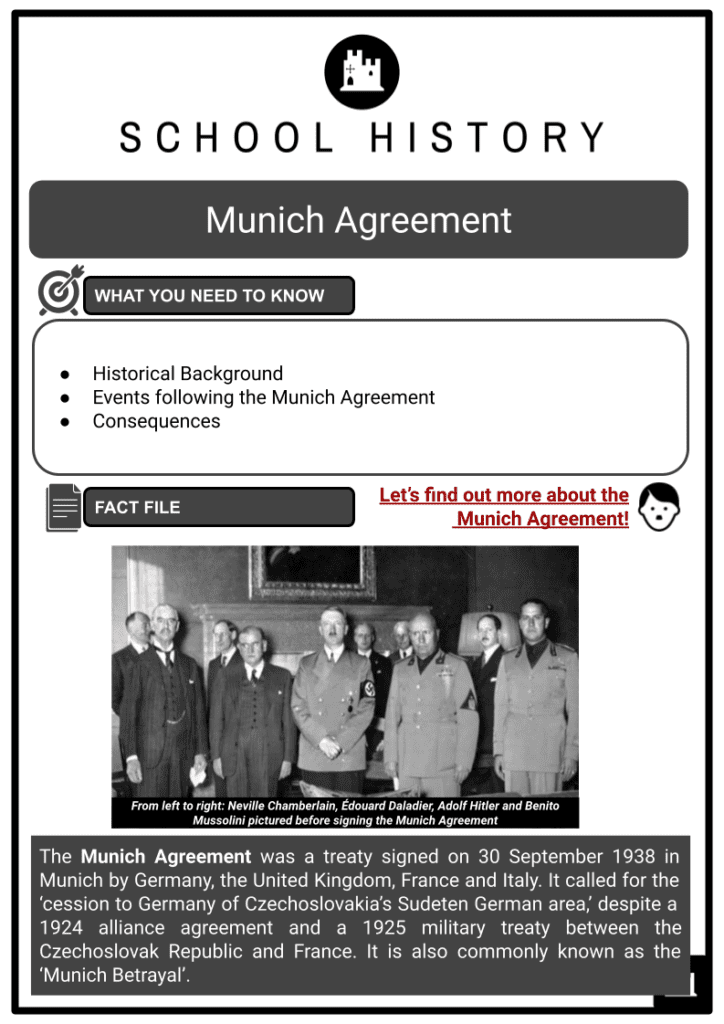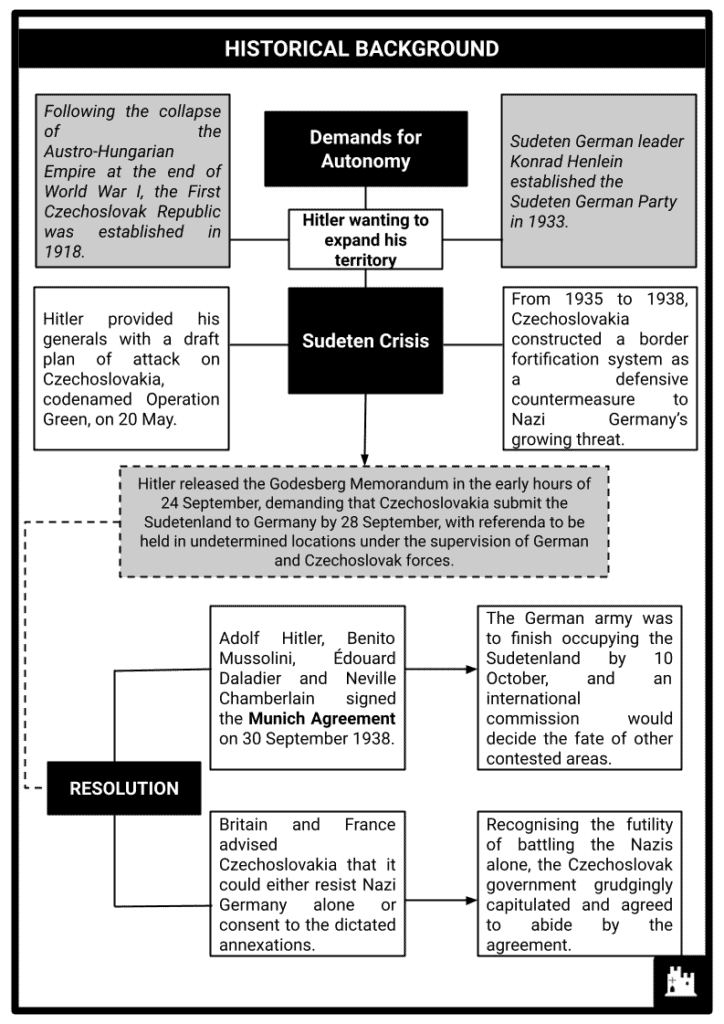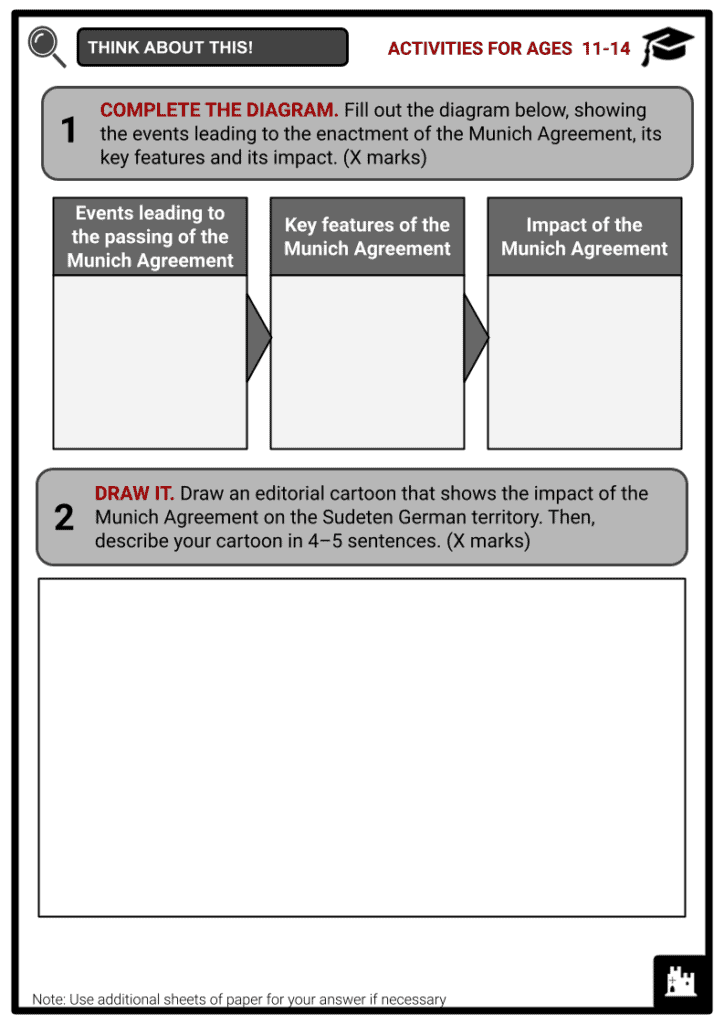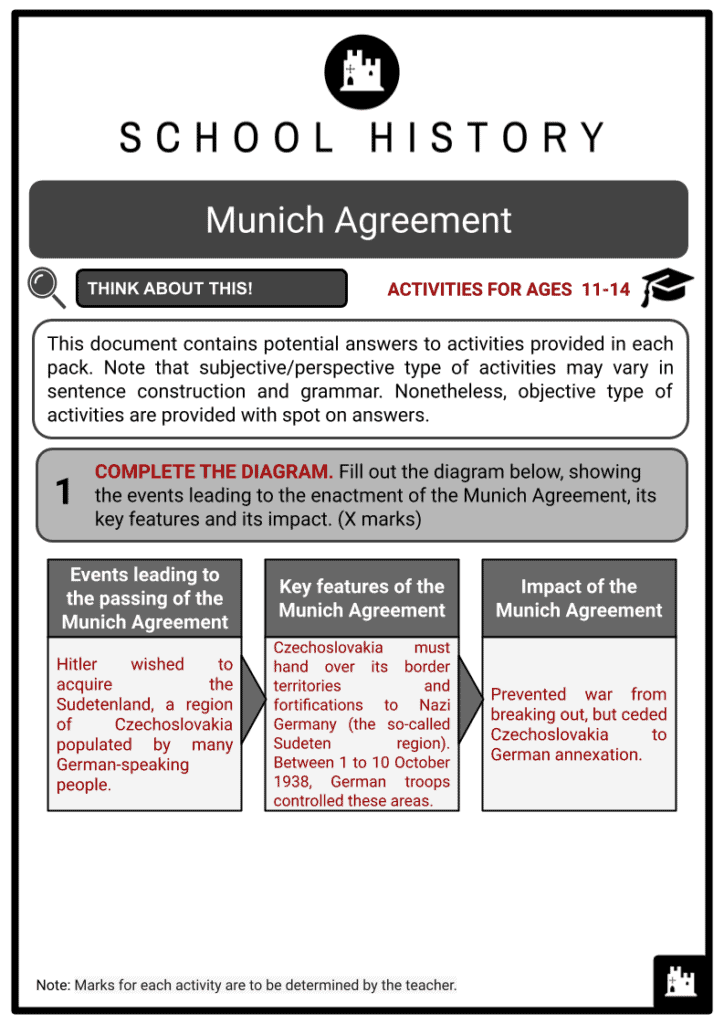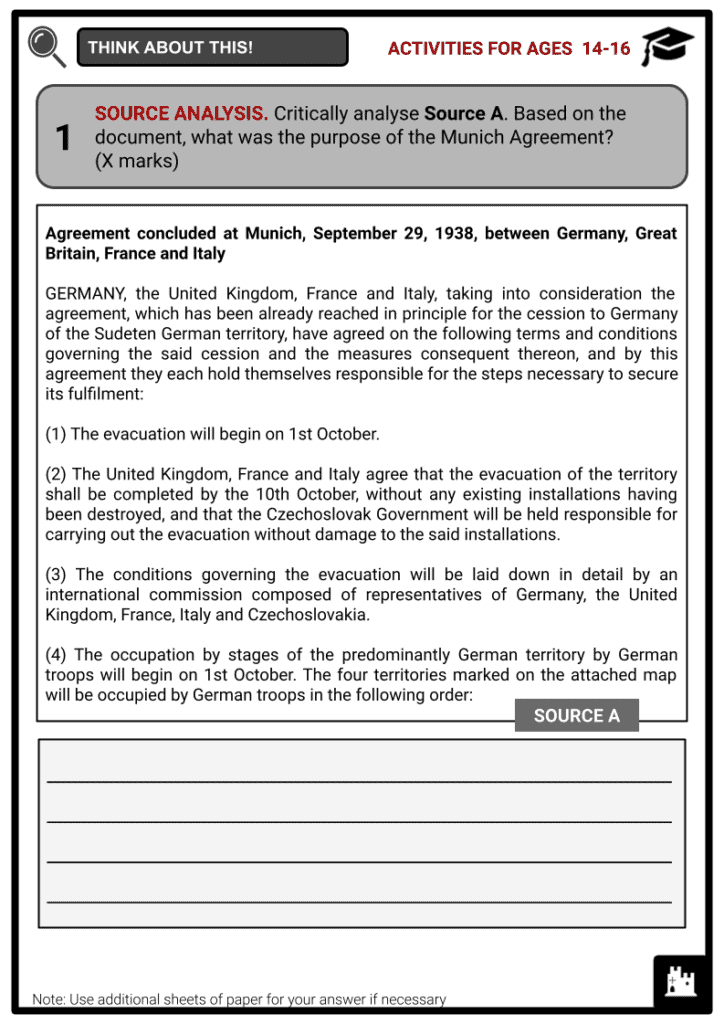Munich Agreement Worksheets
Do you want to save dozens of hours in time? Get your evenings and weekends back? Be able to teach about the Munich Agreement to your students?
Our worksheet bundle includes a fact file and printable worksheets and student activities. Perfect for both the classroom and homeschooling!
Summary
- Historical Background
- Events following the Munich Agreement
- Consequences
Key Facts And Information
Find out more about the Munich Agreement!

The Munich Agreement was a treaty signed on 30 September 1938 in Munich by Germany, the United Kingdom, France and Italy. It called for the ‘cession to Germany of Czechoslovakia’s Sudeten German area,’ despite a 1924 alliance agreement and a 1925 military treaty between the Czechoslovak Republic and France. It is also commonly known as the ‘Munich Betrayal’.
HISTORICAL BACKGROUND
Demands for Autonomy and the Sudeten Crisis
- Following the collapse of the Austro-Hungarian Empire at the end of World War I, the First Czechoslovak Republic was established in 1918.
- Sudeten German leader Konrad Henlein established the Sudeten German Party in 1933.
- Hitler provided his generals with a draft plan of attack on Czechoslovakia, codenamed Operation Green, on 20 May.
- From 1935 to 1938, Czechoslovakia constructed a border fortification system as a defensive countermeasure to Nazi Germany’s growing threat.
- Hitler released the Godesberg Memorandum in the early hours of 24 September, demanding that Czechoslovakia submit the Sudetenland to Germany by 28 September, with referenda to be held in undetermined locations under the supervision of German and Czechoslovak forces.
- Britain and France advised Czechoslovakia that it could either resist Nazi Germany alone or consent to the dictated annexations. Recognising the futility of battling the Nazis alone, the Czechoslovak government grudgingly capitulated and agreed to abide by the agreement.
- Adolf Hitler, Benito Mussolini, Édouard Daladier and Neville Chamberlain signed the Munich Agreement on 30 September 1938. The German army was to finish occupying the Sudetenland by 10 October, and an international commission would decide the fate of other contested areas.
EVENTS FOLLOWING THE MUNICH AGREEMENT
The following events represent the number on the map.
- According to the Munich Agreement, the Sudetenland became a part of Germany in October 1938.
- Poland annexes Zaolzie, a Polish-majority territory for which the two countries fought a war in 1919.
- According to the First Vienna Award, border areas with the Hungarian minority (the southern third of Slovakia and the southern Carpathian Ruthenia) became part of Hungary in November 1938.
- Hungary annexes the remainder of Carpathian Ruthenia on 15 March 1939, during the German invasion of the remaining Czech regions, which had been autonomous since October 1938.
- On 16 March 1939, Germany established the Protectorate of Bohemia and Moravia with a puppet government.
- On 16 March 1939, Germany established the Protectorate of Bohemia and Moravia with a puppet government.
CONSEQUENCES
Czechoslovakia
- The Munich Agreement shocked the Czechoslovaks, and they believed the British and French governments had misled them because they had not received an invitation to the summit.
- The administrations of France, the United Kingdom and Czechoslovakia were steadfast in their desire to avert war at all costs, as evidenced by their muted response to the German Anschluss with Austria.
- The British government, headed by Prime Minister Neville Chamberlain, guided the French government since it wanted to avoid facing Germany alone.
- Chamberlain argued that the grievances of Sudeten Germans were legitimate and thought Hitler’s aims were not very broad.
- A partial mobilisation was in progress on 20 May 1938 in preparation for a potential German invasion.
- On 30 May, Hitler secretly ordered the start of the war against Czechoslovakia no later than 1 October.
- Henlein issued a declaration on 15 September calling for Germany to annex the Sudetenland. Hitler spoke with Chamberlain that day and threatened war unless Nazi Germany quickly annexed the Sudetenland. Hitler claimed that Czechoslovakia had massacred Sudeten Germans.
- Czechoslovakia submitted on 21 September.
- President Benes announced his resignation on 5 October 1938 after realising that the loss of Czechoslovakia was inevitable.
- Early in November 1938, the First Vienna Award, which came about as a result of the Munich Agreement, forced Czechoslovakia to cede after the arbitration of Germany and Italy awarded southern Slovakia and Carpathian Ruthenia to Hungary.

Map showing the partition of Czechoslovakia. First Vienna Award in red.
FIRST VIENNA AWARD TO HUNGARY
- Following the German-Italian arbitration, Czechoslovakia was forced to surrender southern Slovakia to Hungary, and Poland quickly obtained tiny territorial concessions.
- Bohemia, Moravia and Silesia lost approximately 38% of their total area to Germany, with about 2.8 million German and 513,000 to 750,000 Czech residents.
- Soon after Munich, 115,000 Czechs and 30,000 Germans fled to the ruins of Czechoslovakia. According to the Institute for Refugee Assistance, there were over 150,000 refugees on 1 March 1939.
- In the elections held in Reichsgau Sudetenland on 4 December 1938, 97.32% of the adult population cast their ballots in favour of the National Socialist Party. A total of 500,000 Sudeten Germans, or 17.34% of the German population in Sudetenland, joined the National Socialist Party (the average NSDAP membership rate in Nazi Germany was 7.85%).
Second Republic of Czechoslovakia
- Major concessions were made to the non-Czechs by the severely depleted Czechoslovak Republic. On 5 October 1938, the Slovak People’s Party executive committee met in Ilina and, with the consent of all other Slovak parties but the Social Democrats, founded an independent Slovak government led by Jozef Tiso.
- The creation of an autonomous administration was agreed upon by the Russophiles and the Ukrainophiles on 8 October 1938.
- During the takeover in 1939, the Nazis outlawed Russian ballet.
- On 27 January 1939, the British and French governments concluded an agreement of financial assistance with the Czechoslovak government.
- Emil Hácha was chosen as the federated Second Republic’s president in November 1938, succeeding Benes. He renamed it Czecho-Slovakia and it consisted of three parts: Bohemia and Moravia, Slovakia, and Carpatho-Ukraine.
- On 30 January 1939, Hitler made his ‘Export or die!’ speech, calling for a German economic offensive or ‘export battle’ to use Hitler’s term to increase German foreign exchange.
- On 17 March, Chamberlain told the British government during a speech in Birmingham that Hitler was attempting ‘to dominate the world by force’.
- As a result, its supporters have glorified interwar Czechoslovakia as the lone bulwark of freedom surrounded by totalitarian and fascist regimes. Its critics have also denounced it as an artificial and useless invention of intellectuals supported by the major powers.
- Czechoslovakia in the interwar period was made up of areas and peoples that were not yet fully assimilated into a contemporary nation-state.
British Politics
- The Munich Agreement was joyfully received in Britain. Winston Churchill, who was then at odds with the government and one of the few to resist appeasing Hitler, called it ‘an utter calamity’.
- There were many reasons appeasement was preferred by many. Chamberlain and the British people were eager to stay out of another international war and its carnage. As its empire’s police force, Britain was overburdened and unable to fund significant rearmament. France’s main ally was severely compromised and, unlike in the First World War, support from the Commonwealth was not guaranteed.
- Additionally, many British felt sympathy for Germany, which they believed had been unfairly treated after its defeat in 1918. Hitler was not deterred by appeasement, despite his promise of ‘no further territorial demands in Europe’.
- He broke the terms of the Munich Agreement in March 1939 by seizing the remainder of Czechoslovakia. In September 1939, Germany invaded Poland, and at that time Britain was at war.
Berlin-Rome
Birth of German resistance in military
- The Sudeten conflict sparked the so-called Oster conspiracy in Germany. General Hans Oster, the deputy commander of the Abwehr, and other key figures in the German military condemned the regime’s behaviour, which they feared threatened to drag Germany into a war it was not prepared to wage.
- They contemplated ousting Hitler and the regime with a planned disruption of the Reich Chancellery by scheme supporters.
Italian colonial demands from France
- Italy firmly backed Germany in Munich, and a few weeks later, in October 1938, it attempted to use its position to impose new demands on France.
- Mussolini requested a free port in Djibouti, ownership of the Addis Ababa-Djibouti line, Italian participation in Suez Canal Company management, some form of French-Italian buildings over Tunisia, and the preservation of Italian arts and culture in French-held Corsica without French assimilation.

